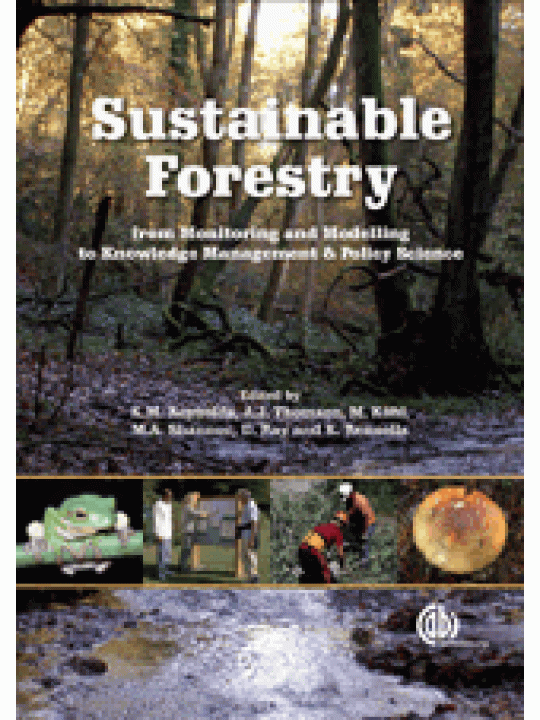Sustainable Forestry: From Monitoring and Modelling to Knowledge Management and Policy Science
Edited by K Reynolds, USDA Forest Service, Oregan, USA; A Thomson, Canadian Forest Service, British Columbia, Canada; M Shannon, State University of New York, USA; M Kohl, University of Hamburg, Germany; D Ray, Forest Research, Roslin, UK; K Rennolls, University of Greenwich, UK,
Pub Date: February 2007
Hardback
576 pages
Readership
Researchers in environmental science, ecology conservation, forest management and biometrics. It will also appeal to inventors, informatics, modellers and forest management professionals.
Main Description
In the context of forest sustainability, this book presents the issues related to both global climate change and conservation of biodiversity. It highlights four methodologies and shows how they contribute in overcoming the ecological challenges facing our world. The practical experience presented can be applied to the implementation of successful sustainable forestry policies.
Main Contents
Overview KM Reynolds, M Kφhl, K Rennolls, M Shannon, A Thomson, and D Ray
Section 1: Science and policy
• Chapter 1. Science is endogenous to sustainable forestry - implications for scientists and policy makers MA Shannon, G Buttoud, and R Pδivinen
• Chapter 2. Will linking science to policy lead to sustainable forestry? Lessons from the federal forests of the United States KN Johnson
• Chapter 3. Participation as a new mode of governance? Scientists and policy makers linked in a double spiral I Kouplevatskaya
• Chapter 4. The European Union sustainable forest management and climate change mitigation policies from a transition countries perspective M Nijnik and L Bizikova
• Chapter 5. Abee
• Chapter 6. Indicators for biodiversity of tropical forests: problems and solutions K Rennolls and KM Reynolds
• Chapter 7. Science-policy consultation as boundary spanning: The interaction of science and politics in two US bioregional assessments M Pregernig
• Chapter 8. Cluster organization in forestry: Supporting information and knowledge transfer in the practice, science and policy of sustainable forest management T Mrosek and A Schulte
• Chapter 9. Modelling public support for wildland fire policy JD Absher and JJ Vaske
• Chapter 10. Analysing institutions and public perspectives to identify the future of British forests M Nijnik and A Mather
• Chapter 11. Economic conservation - Hill Holt Wood: The three legs of sustainability in practice N Lowthrop
Section 2: Inventory and monitoring
• Chapter 12. Measuring sustainability using the US Forest Inventory and Analysis Program CT Scott and WH McWilliams
• Chapter 13. Vegetation diversity assessment in southern Belgium's permanent forest inventory C Sanchez, H Claessens, T Puissant, HLecomte and JRondeux
• Chapter 14. PractiSFM - An operational multi-resource inventory protocol for sustainable forest management F Barrett, M Nieuwenhuis and MJ Somers
• Chapter 15. The Importance of forest stand-level inventory to sustain multiple forest values in the presence of endangered species DL Johnson, KN Johnson and DW Hann
• Chapter 16. Forest land change assessment by continuous inventory P Corona, E Pompei and G Scarascia Mugnozza
• Chapter 17. A study on tree colonization of abandoned land in the Italian Alps: extent and some characteristics of new forest stands in Trentino F De Natale, P Gasparini and A Carriero
• Chapter 18. Using spatial statistics to improve the primary forestry supply chain JD Hamann and K Boston
• Chapter 19. Evaluation of commercial airborne LiDAR and SAR products to estimate top height and associated parameters in production forests in Britain E D Wallington and JC Suαrez
Section 3: Statistics and modelling
• Chapter 20. Potential contributions of statistics and modelling to sustainable forest management: review and synthesis K Rennolls, M Tomι, RE McRoberts, JK Vanclay, V LeMay, BT Guan and GZ Gertner
• Chapter 21. Modelling forest ecosystems: the Edinburgh Forest Model JHM Thornley
Section 4: Information and knowledge management
• Chapter 22. Information and knowledge management for sustainable forestry AJ Thomson, HM Rauscher, DL Schmoldt and H Vacik
• Chapter 23. Integrating the DPSIR approach and the analytic network process for the assessment of forest management strategies H Vacik, B Wolfslehner, R Seidl and MJ Lexer
• Chapter 24. Establishment Management Information System [EMIS]: delivering good practice advice on tree establishment in the uplands of Britain MP Perks, AJ Harrison and SJ Bathgate
• Chapter 25. On chatbots and avatars - the Virtual Forester as a guide to knowledge about sustainable forest management A Reinbolz and M Hanewinkel
• Chapter 26. Information and knowledge management in support of sustainable forestry: a review HM Rauscher, DL Schmoldt and H Vacik
• Chapter 27. How should we manage knowledge ecosystems? Using adaptive knowledge management! AJ Thomson
• Chapter 28. An information retrieval system to support management of Habitats and Rare Priority and Protected Species (HaRPPS) in Britain D Ray and AC Broome
• Chapter 29. Decision support for sustainable forestry: enhancing the basic rational model HR Ekbia and KM Reynolds

